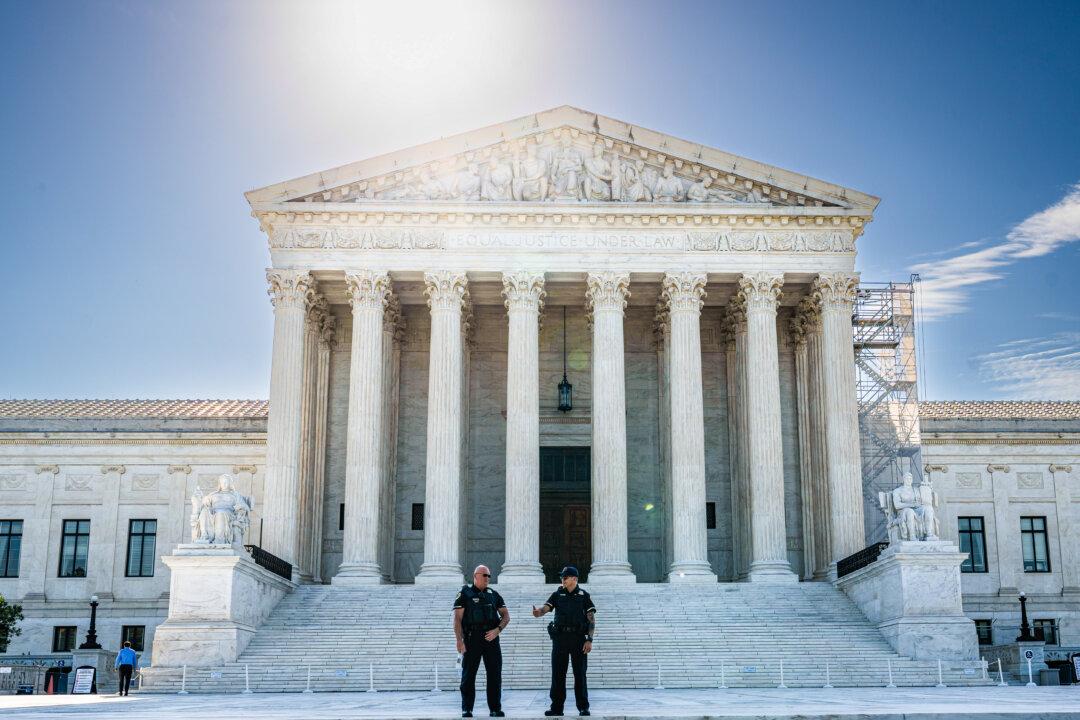The Supreme Court on June 21 upheld by 8–1 a federal gun control law that bars people under domestic violence-related restraining orders from possessing firearms.
The justices found that the Second Amendment to the U.S. Constitution isn’t violated when an individual is disarmed after a court has found him to pose a credible threat to the physical safety of another. The ruling reversed a lower court decision that overturned a federal law.
The new decision comes in the wake of the Supreme Court’s landmark 2022 ruling in New York State Rifle and Pistol Association v. Bruen. That decision recognized a constitutional right to bear arms in public for self-defense and held that restrictions on guns must be deeply rooted in American history if they are to survive constitutional scrutiny.
The case of United States v. Rahimi concerns a February 2023 ruling by the U.S. Court of Appeals for the Fifth Circuit that struck down Section 922(g)(8) of Title 18 of the U.S. Code, a 1994 law that prohibits a person who is subject to a domestic restraining order from having a gun.
The Fifth Circuit held the statute had ceased to be constitutional in light of the Bruen precedent.
The ban on the possession of firearms by someone under a domestic restraining order “is an outlier that our ancestors would never have accepted,” the circuit court said at the time.
Facts of the Case
The court’s opinion recounted several of the incidents that led to the issuance of a restraining order against Mr. Rahimi.In 2019, Mr. Rahimi met with his girlfriend, who is the mother of their young child, for lunch in a parking lot. At one point, he became enraged, and when the girlfriend tried to leave, Mr. Rahimi dragged her back to his vehicle, causing her to hit her head on the dashboard.
Mr. Rahimi grabbed his gun from under the passenger seat, which gave the girlfriend an opportunity to flee the scene. As she ran away, he fired his gun, although it’s unclear if he was aiming at her or at a nearby witness.
Mr. Rahimi later called his girlfriend and said he would shoot her if she reported the incident to authorities, the opinion states.
A state court in Tarrant County, Texas, issued a restraining order against him, which found that Mr. Rahimi had committed “family violence.” The order also stated that this violence was “likely to occur again” and that he presented “a credible threat” to the “physical safety” of the girlfriend.
The order suspended Mr. Rahimi’s gun license for two years, and prohibited him from contacting his girlfriend during that period except to discuss their child.
But he violated the order by approaching her home at night and by using social media accounts to contact her.
In subsequent incidents, he was charged with threatening a different woman with a gun. While in custody, police identified him as a suspect in at least five additional shootings.
After obtaining a search warrant, the police found a pistol, a rifle, ammunition, and a copy of the restraining order in his home. He was indicted for possessing a firearm while subject to a domestic violence restraining order, and asked the federal district court to dismiss the indictment, which he argued violated the Second Amendment.
The district court denied the motion and he entered a guilty plea. He appealed on Second Amendment grounds, but the Fifth Circuit ruled against him.
He asked the circuit court to rehear the case, and while the request was pending, the Supreme Court handed down the Bruen ruling, the opinion states.
In light of Bruen, the Fifth Circuit withdrew its opinion. After a new hearing, the circuit court reversed its ruling and found for Mr. Rahimi.
In a brief, U.S. Solicitor General Elizabeth Prelogar said the Fifth Circuit ruling had “significant disruptive consequences.”
Mr. Rahimi’s attorney, assistant federal public defender Matthew Wright, said that when Congress enacted the law in 1994, it acted without the benefit of recent Supreme Court rulings.
The Court’s Ruling
In the new opinion, Chief Justice Roberts wrote that since the United States was founded, its firearms laws have provided ways to stop individuals who threaten physical harm to others by misusing guns.The law at issue in this case fits “comfortably” within this tradition, he writes.
In the 1700s and early 1800s, two different systems evolved to address gun-related violence.
Laws were enacted empowering judicial officers to require individuals suspected of future misbehavior to post a bond, also known as a surety. Failing to deliver the bond could lead to the individual being jailed. If the individual broke the peace, the bond would be forfeited, meaning he would lose the money deposited, he wrote.
In the United States, breaking the peace involves engaging in loud or violent behavior in a public place. The Constitution places limits on how far governments can go to protect the peace.
Surety laws could also be invoked to prevent all forms of violence, including spousal abuse, and could target the misuse of firearms. Such laws provide the accused person with procedural safeguards, Chief Justice Roberts wrote.
Although the court held in McDonald v. Chicago (2010) that the right to keep and bear arms is among the “fundamental rights necessary to our system of ordered liberty,” it also held in District of Columbia v. Heller (2008) that the right “is not unlimited.”
When the United States was created, the bearing of arms was subject to regulations, including rules about storage and restrictions on their use. Some jurisdictions outlawed the carrying of “dangerous and unusual weapons” and carrying concealed firearms.
A challenged regulation will be upheld if it conforms to the principles underlying the Second Amendment.
“Bearing these principles in mind, we conclude that Section 922(g)(8) survives Rahimi’s challenge,” the opinion states.
Justice Thomas Dissents
Justice Thomas filed a dissenting opinion.In Bruen, the Court held a firearm regulation is unconstitutional unless “it is consistent with the Nation’s historical tradition of firearm regulation. Not a single historical regulation justifies the statute at issue,” he writes.
The presumption against firearms restrictions “is a central feature of the Second Amendment. That Amendment does not merely narrow the Government’s regulatory power. It is a barrier, placing the right to keep and bear arms off limits to the Government.”
The statute in issue “violates the Second Amendment” by targeting the possession of firearms, which is “at the core of the Second Amendment,” Justice Thomas writes.
The government’s evidence about old surety laws, which are a “materially different means” of regulating guns, isn’t persuasive, he adds.
The Second Amendment covers “the people,” and that term “unambiguously refers to all members of the political community, not an unspecified subset.”
Reactions
Carrie Severino, president of the conservative Judicial Crisis Network, wrote on X, the former Twitter, that the Court “did just what we expected.”The court’s finding was “modest,” she wrote, adding that it “rejected as vague the government’s contention that Rahimi may be disarmed simply because he is not ‘responsible.’”
She described Justice Thomas’s dissent as “compelling” for arguing, among other things, that surety and so-called going armed laws are “not appropriate historical analogues.”
“This case is yet another illustration of the obvious reality that the Court is not in the tank for one side over another, but rather working to apply neutral principles that promote the rule of law,” Ms. Severino wrote.
Brady United Against Gun Violence, a gun control group, praised the Supreme Court’s ruling.
“This is an important victory for gun violence and domestic violence prevention,” Douglas Letter, the group’s chief legal officer, said in a statement.
“Guns are the number one weapon of choice for domestic abusers, and there is no reason why anyone who is a known danger should be permitted access to firearms.”







